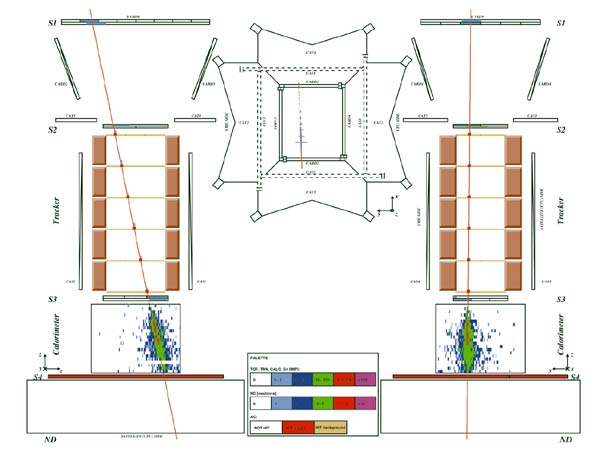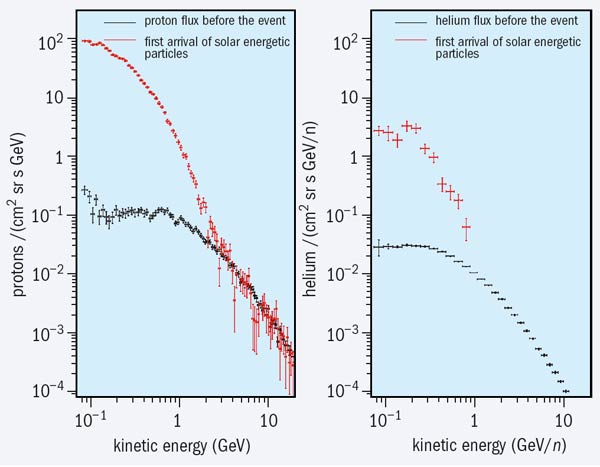The latest results after five years in space.

PAMELA – the Payload for Antimatter Matter Exploration and Light nuclei Astrophysics – was launched into space on 15 June 2006 aboard a Soyuz rocket from Bajkonur in Kazakhstan. Since then, it has been orbiting the Earth, installed on the upward side of the Resurs-DK1 satellite at a distance that varies between 350 km and 610 km. On board are different types of detector (figure 1) comprising: a magnetic spectrometer, based on a neodymium-iron-boron permanent magnet and a precision tracking system; a sampling imaging calorimeter, in which pairs of orthogonal millistrip silicon sensor planes are interleaved with tungsten absorber plates; a precise time-of-flight system, using plastic scintillation detectors; an anticoincidence system; and a neutron detector.
The experimental apparatus was designed to provide precise measurements of the particle and nuclei fluxes in the cosmic radiation over a wide energy range. It is sensitive to antiprotons between 80 MeV and 190 GeV, positrons between 50 MeV and 270 GeV, electrons up to 600 GeV, protons up to 1 TeV and nuclei up to a few hundred giga-electron-volts. In addition, in the search for antinuclei PAMELA has a sensitivity of about 10–7 in the ratio He/He.
The experiment’s scientific objectives are ambitious and aim to clarify some of the trickiest questions of modern physics: the origin of cosmic rays, their energy spectrum, their antimatter components and particles possibly originating in the annihilation of dark matter particles. With data accumulated over several years, the mission, which is scheduled to finish at the end of the year, is now providing new insights into some of these questions and more.
Cosmic revelations
In 2009, the PAMELA collaboration published an anomalous positron abundance in cosmic rays with energies between 1.5 and 100 GeV. By contrast, as figure 2 shows, the antiproton flux they observe agrees with standard secondary antiproton production in the Galaxy (Adriani et al. 2010). These results were followed more recently with the publication of precision measurements of the proton and helium spectra in the rigidity range 1 GV to 1.2 TV. The proton and helium spectra show different shapes and moreover cannot be described by a single power law, as would be expected from previous observations and from the theoretical models adopted so far. Also, while the spectra of protons and helium gradually soften in the rigidity range 30–230 GV, they both show a hardening at 230–240 GV. Previous experiments did not have the statistical and systematic precision to show this behaviour, although an indirect indication was derived by comparing the results from a range of balloon-borne experiments (JACEE, CREAM and BESS) as well as from the first trial flight of the Alpha Magnetic Spectrometer in 1998.

So far, supernovae have been considered to be the sites of cosmic-ray acceleration. However, the discrepancies found by PAMELA in the proton and helium spectra have prompted a re-evaluation of the processes that underlie the acceleration, as well as the propagation of cosmic rays. Similar conclusions were drawn from PAMELA’s results on the positron abundance. Theoretical explanations of these data invoke more complex processes of acceleration and propagation, as well as possible contributions from new astrophysical sources, such as pulsars or more exotic ones, such as dark matter.
Conventional diffusive propagation models can, on the other hand, be used to interpret recently published PAMELA data on the electron component of the cosmic radiation. Precision measurements of the electron flux provide information regarding the origin and propagation of cosmic rays in the Galaxy that are not accessible through the study of the cosmic-ray nuclear components because of their differing energy-loss processes. PAMELA collected data between July 2006 and January 2010 by selecting electrons in the energy interval 1–625 GeV. This is the largest energy range covered by any cosmic-ray experiment so far, and the first time that electrons above 50 GeV have been identified in cosmic rays.

The collaboration derived the electron spectrum in two independent ways – using either the calorimeter or the tracking information – and the two sets of measurements show good agreement within the statistical errors. Figure 3 shows a typical electron event with a track and energy deposited in the calorimeter. The electron spectrum, although in substantial agreement with the results of other recent experiments, in particular the balloon-bourn Advanced Thin Ionization Calorimeter (ATIC) and the Fermi Gamma-Ray Space Telescope, appears softer than the e–+e+ spectra they measure. This difference is within the systematic uncertainties between the various measurements, but it is also consistent with a positron component that increases with energy.
Solar events
PAMELA has also measured solar-particle events and their temporal evolution during the major solar emissions of 13–14 December 2006 (figure 4). This was the first direct measurement by a single instrument of proton and helium nuclei of solar origin in a large energy range between 100 MeV/n and 3 GeV/n (Adriani et al. 2011b). The data show a spectral behaviour that is different from those derived from the neutron monitor network, with no satisfactory analytical description fitting the measured spectra. This implies the presence of complex, concurrent acceleration and propagation processes at the Sun and in interplanetary space. Modelling the solar-particle events is also relevant for future manned missions to the Moon and Mars.

Over the past five years, PAMELA has continuously monitored solar activity during an unusually long-lasting solar minimum, followed by – as of the end of December 2009 – a slow increase of activity, probably marking the beginning of the new solar cycle. This particularly favourable situation is providing the collaboration with an excellent opportunity to study heliospheric effects and underlines the major role that the experiment has in providing unique information about the nature of the cosmic rays at the scale of giga-electron-volts in the heliosphere. By combining data from PAMELA and the ULYSSES space mission, the PAMELA collaboration has also performed a new evaluation of the spatial dependence of cosmic-ray intensities in the heliosphere, with an accurate measurement of the radial and longitudinal gradients (De Simone et al. 2011).

Many new results from PAMELA were presented recently at the 2011 European Physical Society Conference on High-Energy Physics in Grenoble on 21–27 July and at the International Cosmic Ray Conference in Beijing on 11–18 August, as well as at other conferences. These results concern mainly new data on the electron/positron ratio, the absolute flux of positrons up to 100 GeV, fluxes and ratios of light nuclei, the abundance of hydrogen and helium isotopes, as well as new limits of the anti-helium to helium ratio. The new results confirm earlier findings and also extend the energy range and precision of the data. One interesting feature concerns the change in slope of the positron flux above 20 GeV, as shown in figure 5, which also includes the electron spectrum. Exclusion limits on the existence of new sorts of matter, such as strangelets, are also in the pipeline. The latest interesting PAMELA result concerns the discovery of a radiation belt around the Earth containing trapped antiprotons (Adriani et al. 2011c).
Although all the instrumentation aboard PAMELA is working well, the mission is expected to finish at the end of this year. The collaboration will then continue to work for another two years to analyse all of the data collected and improve the statistics.
• PAMELA was constructed by the WiZard collaboration, which was originally formed around Robert Golden, who first observed antiprotons in space. There are now 14 institutions involved. Italian INFN groups in Bari, Florence, Frascati, Naples, Rome Tor Vergata and Trieste, and groups from CNR, Florence and the Moscow Engineering and Physics Institute form the core. They are joined by groups from The Royal Institute of Technology (KTH) in Sweden, Siegen University in Germany and Russian groups from the Lebedev Institute, Moscow, and the Ioffe Institute, St Petersburg.





